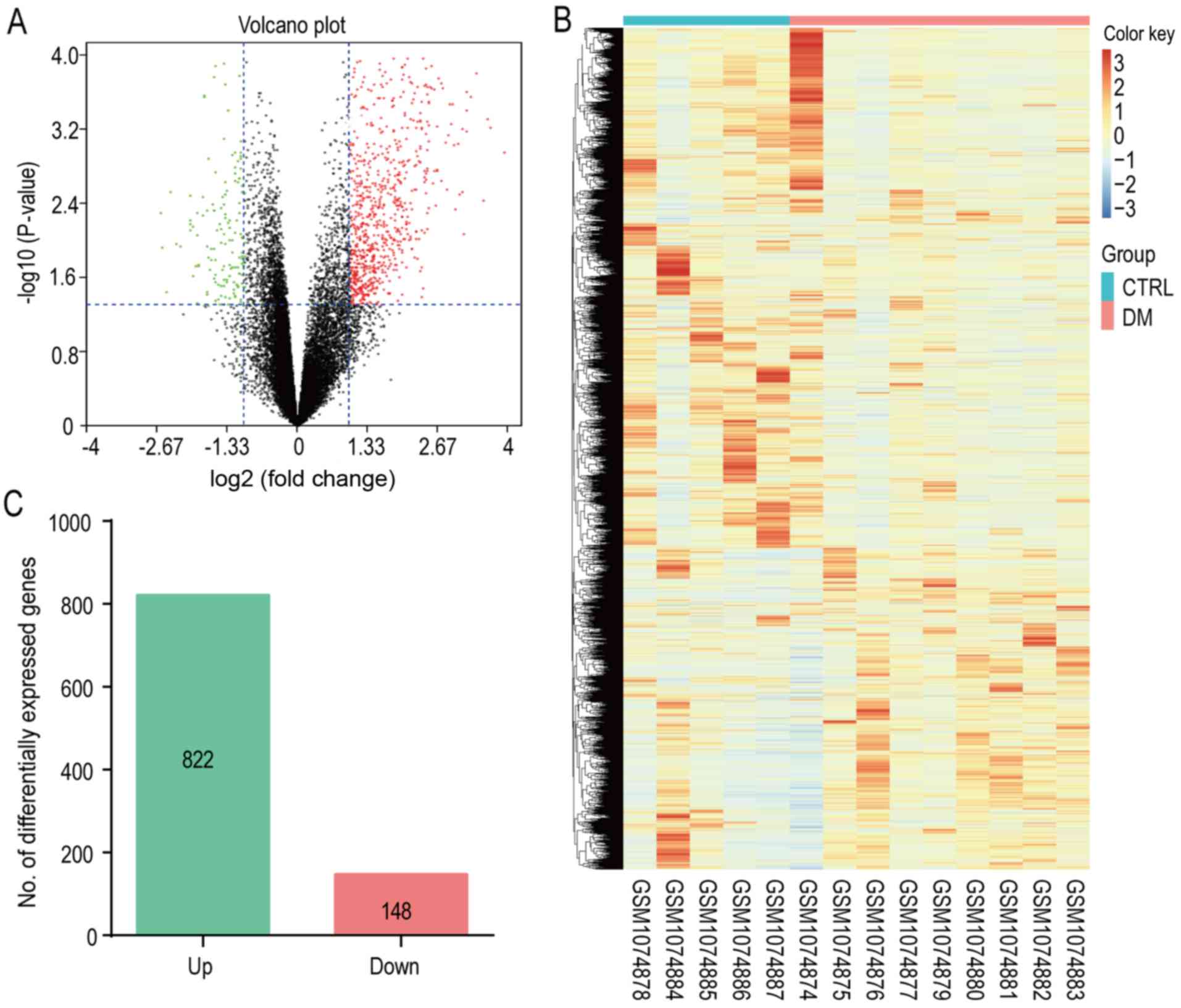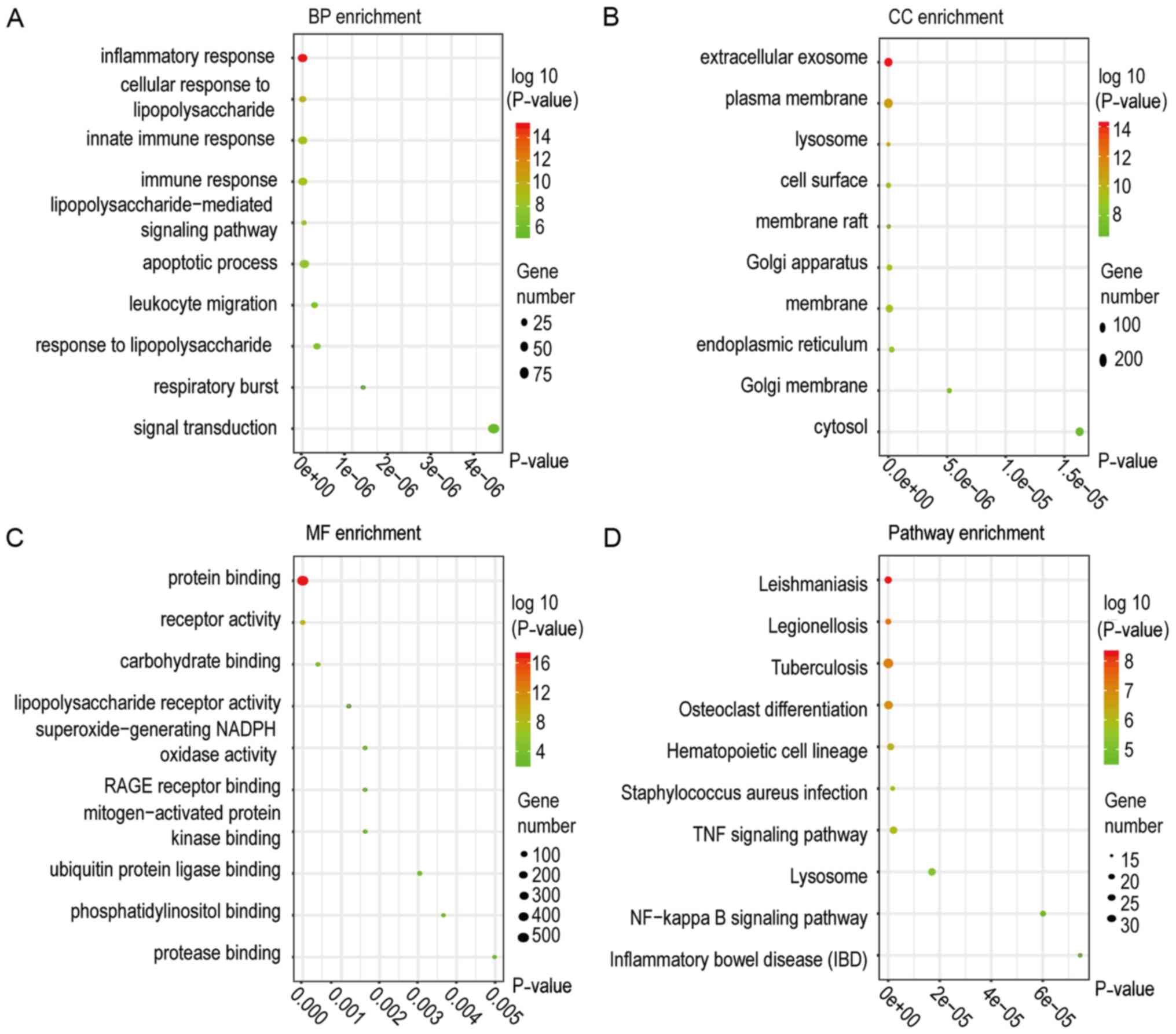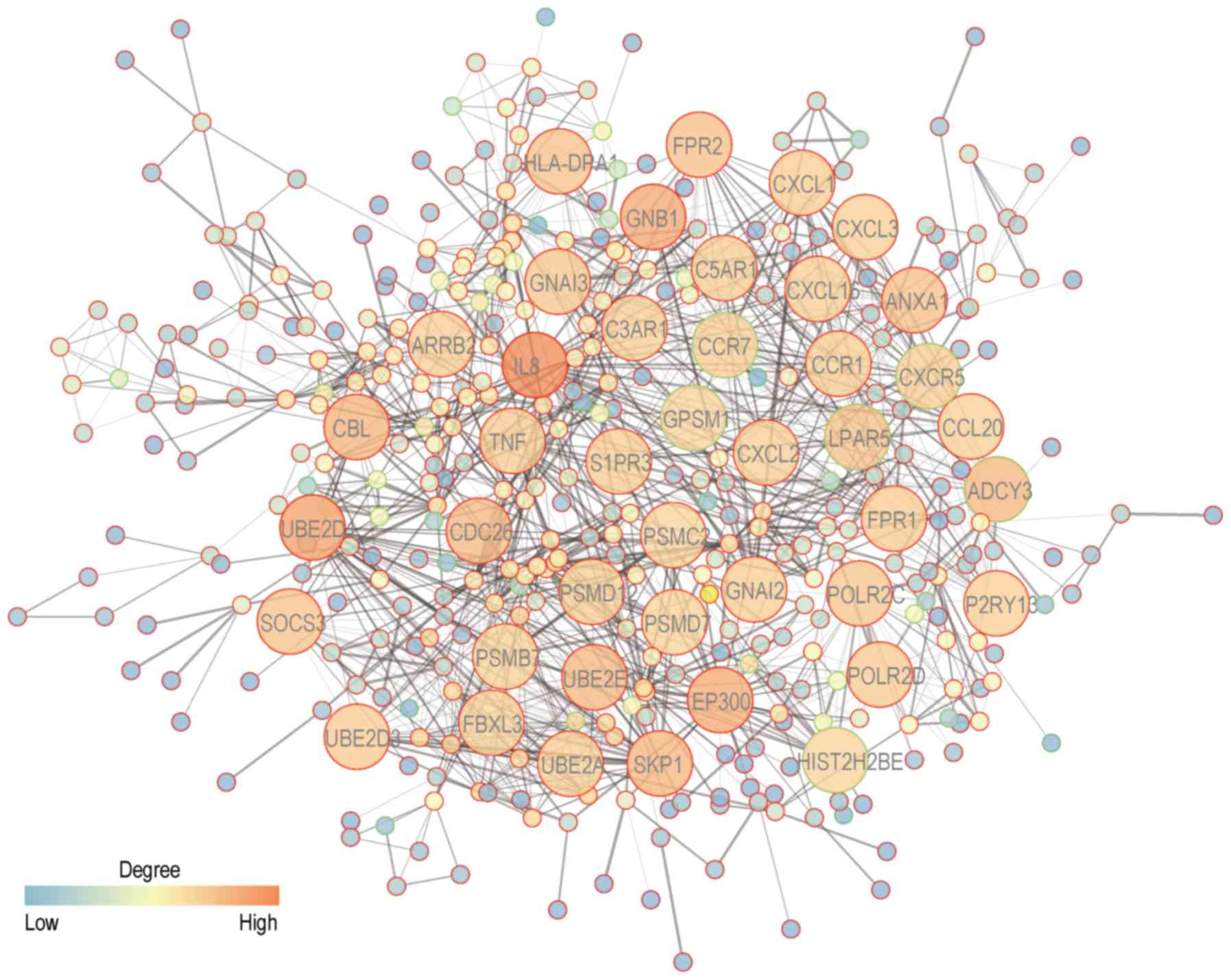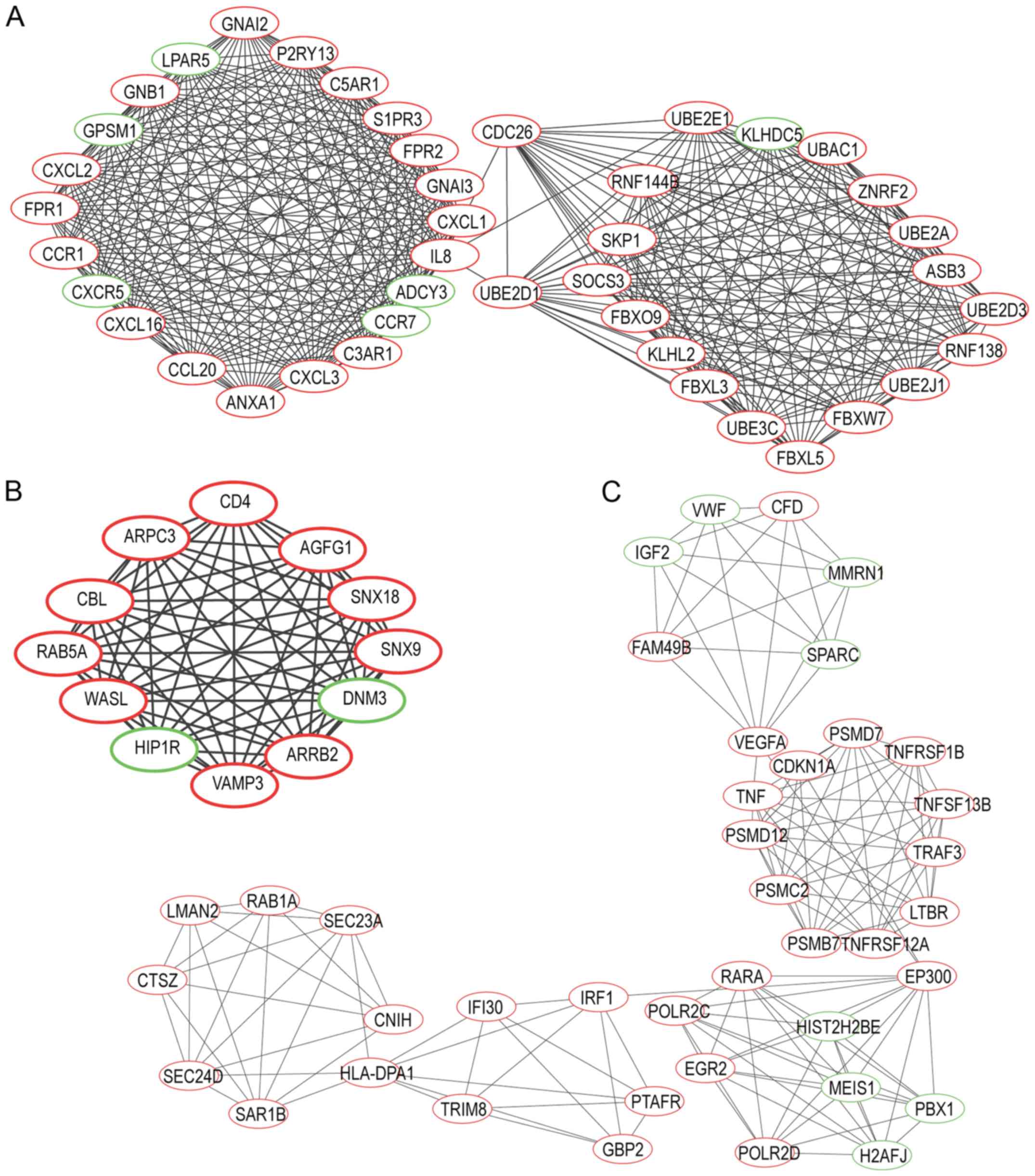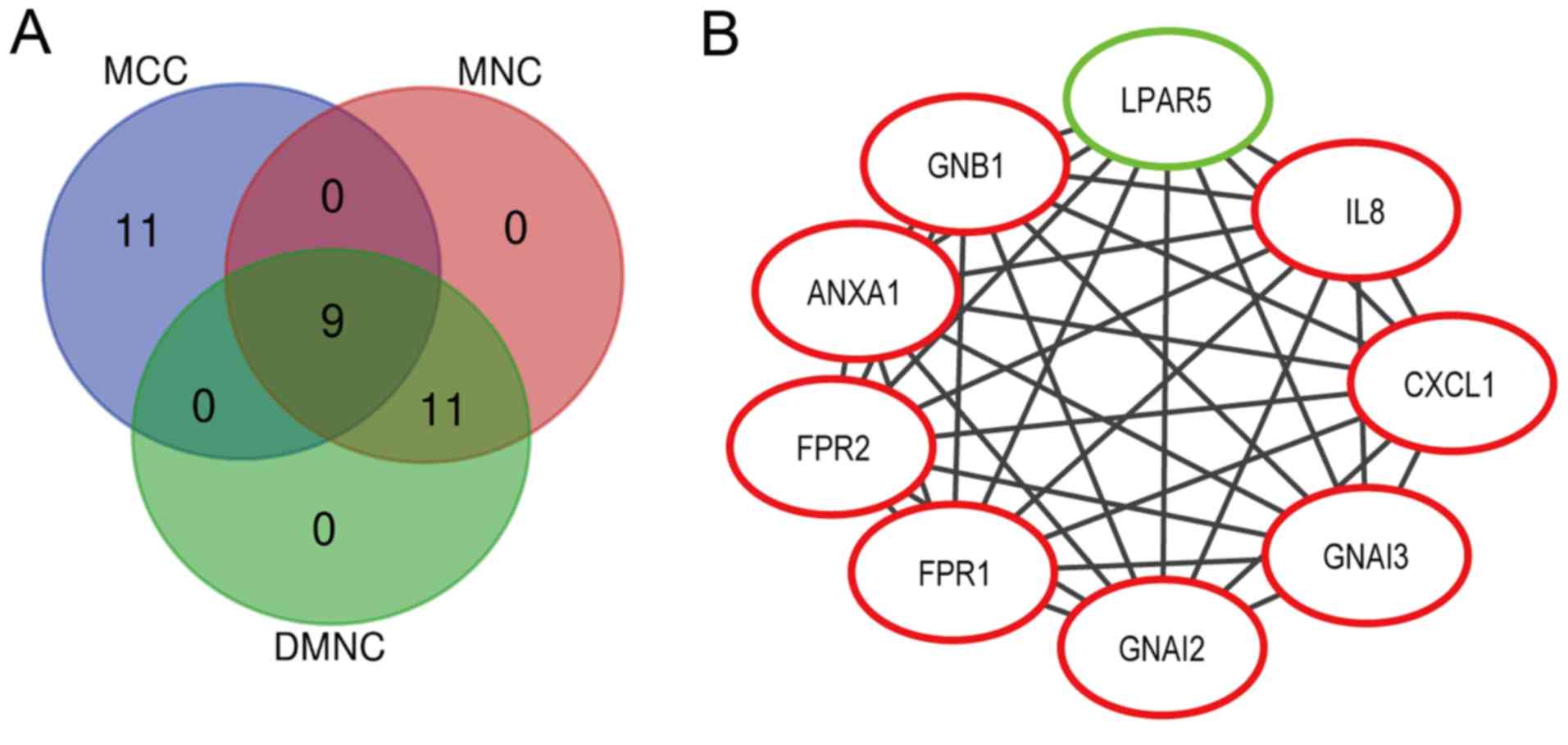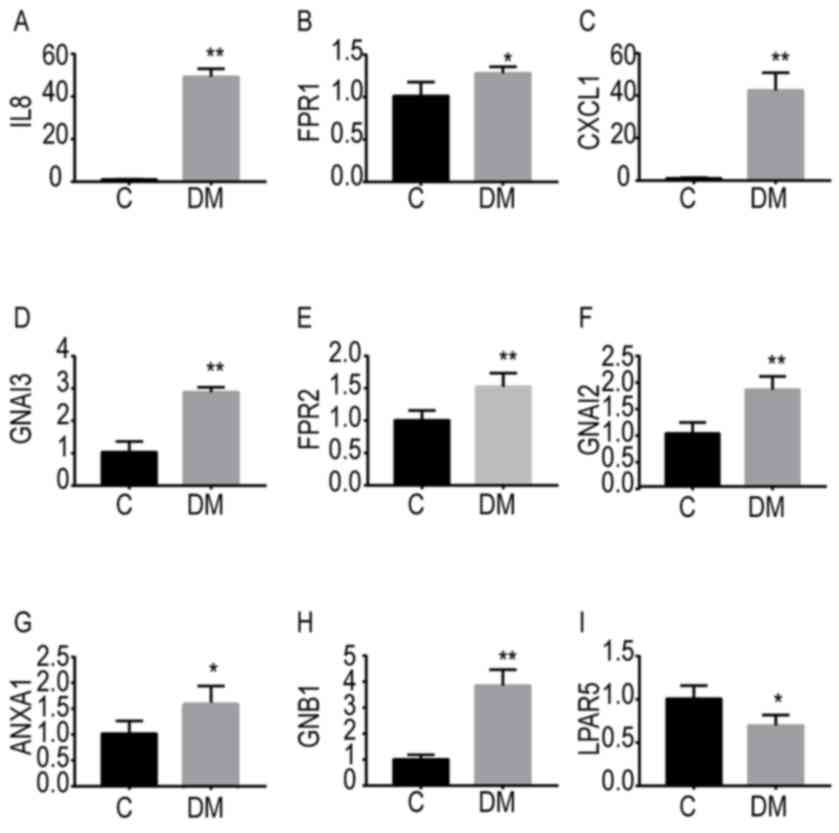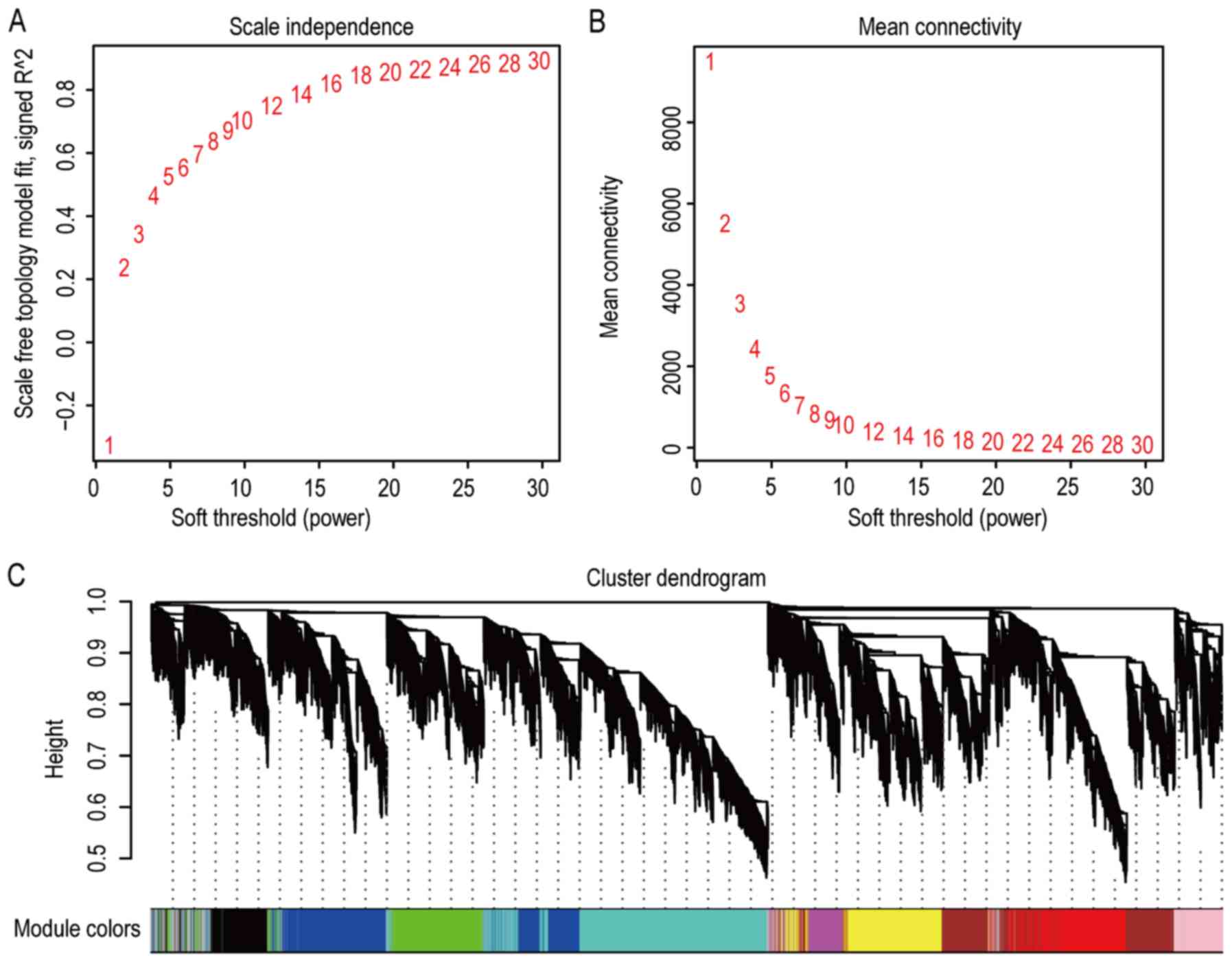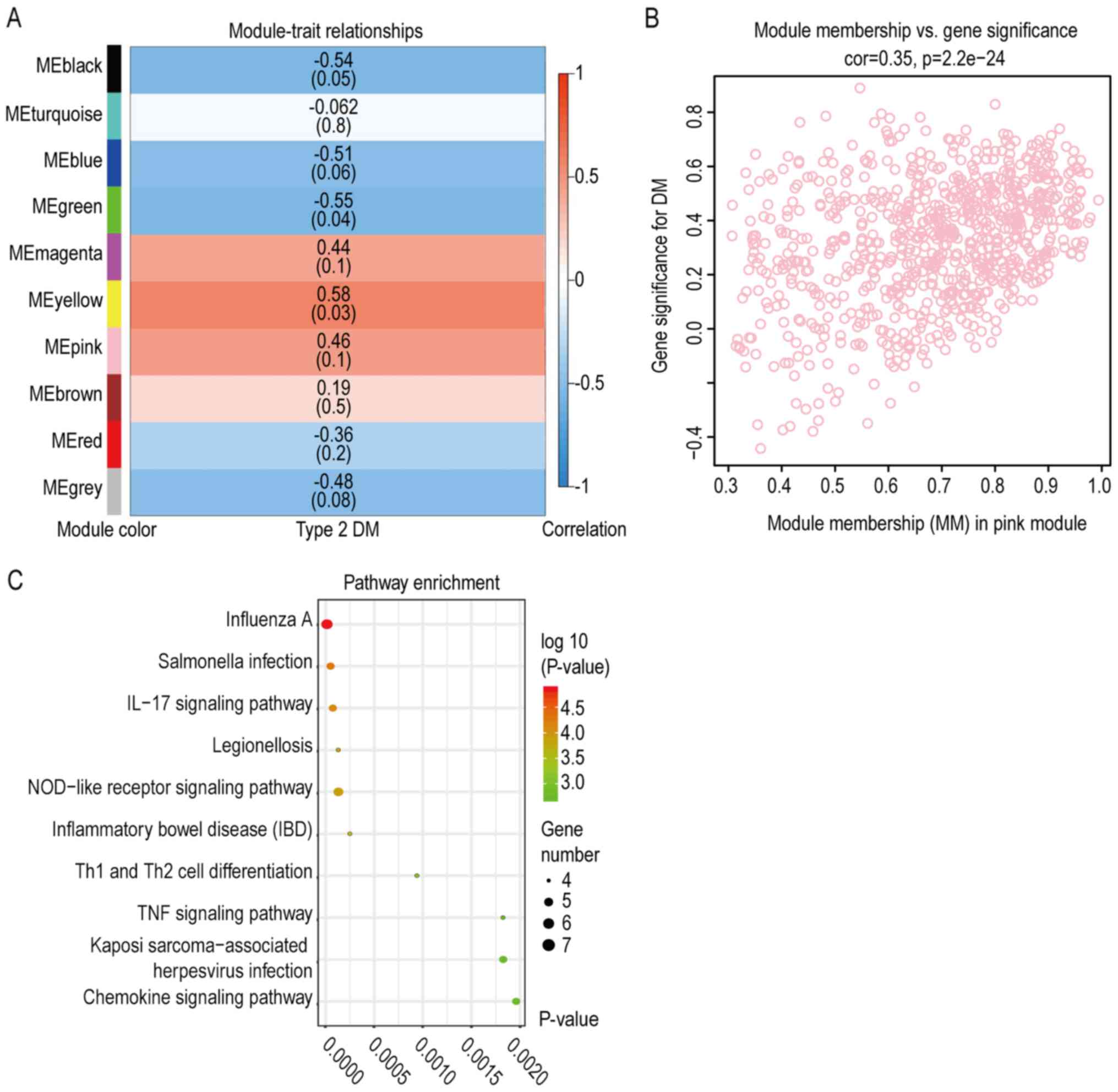|
1
|
Shi Y and Vanhoutte PM: Macro- and
microvascular endothelial dysfunction in diabetes. J Diabetes.
9:434–449. 2017. View Article : Google Scholar : PubMed/NCBI
|
|
2
|
Yang C, Kelaini S, Caines R and Margariti
A: RBPs play important roles in vascular endothelial dysfunction
under diabetic conditions. Front Physiol. 9:13102018. View Article : Google Scholar : PubMed/NCBI
|
|
3
|
Zhang HN, Xu QQ, Thakur A, Alfred MO,
Chakraborty M, Ghosh A and Yu XB: Endothelial dysfunction in
diabetes and hypertension: Role of microRNAs and long non-coding
RNAs. Life Sci. 213:258–268. 2018. View Article : Google Scholar : PubMed/NCBI
|
|
4
|
Giacco F and Brownlee M: Oxidative stress
and diabetic complications. Circ Res. 107:1058–1070. 2010.
View Article : Google Scholar : PubMed/NCBI
|
|
5
|
Zimmet P, Alberti KG and Shaw J: Global
and societal implications of the diabetes epidemic. Nature.
414:782–787. 2001. View
Article : Google Scholar : PubMed/NCBI
|
|
6
|
Vijan S: In the clinic. Type 2 diabetes.
Ann Intern Med. 152:ITC31-15; quiz ITC316. 2010. View Article : Google Scholar
|
|
7
|
Pyšná A, Bém R, Němcová A, Fejfarová V,
Jirkovská A, Hazdrová J, Jude EB and Dubský M: Endothelial
progenitor cells biology in diabetes mellitus and peripheral
arterial disease and their therapeutic potential. Stem Cell Rev.
15:157–165. 2019. View Article : Google Scholar
|
|
8
|
Asahara T, Murohara T, Sullivan A, Silver
M, van der Zee R, Li T, Witzenbichler B, Schatteman G and Isner JM:
Isolation of putative progenitor endothelial cells for
angiogenesis. Science. 275:964–967. 1997. View Article : Google Scholar : PubMed/NCBI
|
|
9
|
Asahara T and Kawamoto A: Endothelial
progenitor cells for postnatal vasculogenesis. Am J Physiol Cell
Physiol. 287:C572–579. 2004. View Article : Google Scholar : PubMed/NCBI
|
|
10
|
Dubsky M, Jirkovska A, Bem R, Nemcova A,
Fejfarova V and Jude EB: Cell therapy of critical limb ischemia in
diabetic patients-State of art. Diabetes Res Clin Pract.
126:263–271. 2017. View Article : Google Scholar : PubMed/NCBI
|
|
11
|
Amann B, Luedemann C, Ratei R and
Schmidt-Lucke JA: Autologous bone marrow cell transplantation
increases leg perfusion and reduces amputations in patients with
advanced critical limb ischemia due to peripheral artery disease.
Cell Transplant. 18:371–380. 2009. View Article : Google Scholar : PubMed/NCBI
|
|
12
|
Liao YF, Chen LL, Zeng TS, Li YM, Fan Yu,
Hu LJ and Ling Yue: Number of circulating endothelial progenitor
cells as a marker of vascular endothelial function for type 2
diabetes. Vasc Med. 15:279–285. 2010. View Article : Google Scholar : PubMed/NCBI
|
|
13
|
Sibal L, Aldibbiat A, Agarwal SC, Mitchell
G, Oates C, Razvi S, Weaver JU, Shaw JA and Home PD: Circulating
endothelial progenitor cells, endothelial function, carotid
intima-media thickness and circulating markers of endothelial
dysfunction in people with type 1 diabetes without macrovascular
disease or microalbuminuria. Diabetologia. 52:1464–1473. 2009.
View Article : Google Scholar : PubMed/NCBI
|
|
14
|
Tepper OM, Galiano RD, Capla JM, Kalka C,
Gagne PJ, Jacobowitz GR, Levine JP and Gurtner GC: Human
endothelial progenitor cells from type II diabetics exhibit
impaired proliferation, adhesion, and incorporation into vascular
structures. Circulation. 106:2781–2786. 2002. View Article : Google Scholar : PubMed/NCBI
|
|
15
|
Yiu KH and Tse HF: Specific role of
impaired glucose metabolism and diabetes mellitus in endothelial
progenitor cell characteristics and function. Arterioscler Thromb
Vasc Biol. 34:1136–1143. 2014. View Article : Google Scholar : PubMed/NCBI
|
|
16
|
Chen LL, Liao YF, Zeng TS, Yu F, Li HQ and
Feng Y: Effects of metformin plus gliclazide compared with
metformin alone on circulating endothelial progenitor cell in type
2 diabetic patients. Endocrine. 38:266–275. 2010. View Article : Google Scholar : PubMed/NCBI
|
|
17
|
Chang TT, Lin LY and Chen JW: Inhibition
of macrophage inflammatory protein-1β improves endothelial
progenitor cell function and ischemia-induced angiogenesis in
diabetes. Angiogenesis. 22:53–65. 2019. View Article : Google Scholar : PubMed/NCBI
|
|
18
|
Ambasta RK, Kohli H and Kumar P: Multiple
therapeutic effect of endothelial progenitor cell regulated by
drugs in diabetes and diabetes related disorder. J Transl Med.
15:1852017. View Article : Google Scholar : PubMed/NCBI
|
|
19
|
Cheng CC, Chang SJ, Chueh YN, Huang TS,
Huang PH, Cheng SM, Tsai TN, Chen JW and Wang HW: Distinct
angiogenesis roles and surface markers of early and late
endothelial progenitor cells revealed by functional group analyses.
BMC Genomics. 14:1822013. View Article : Google Scholar : PubMed/NCBI
|
|
20
|
Gentleman RC, Carey VJ, Bates DM, Bolstad
B, Dettling M, Dudoit S, Ellis B, Gautier L, Ge Y, Gentry J, et al:
Bioconductor: Open software development for computational biology
and bioinformatics. Genome Biol. 5:R802004. View Article : Google Scholar : PubMed/NCBI
|
|
21
|
Reiner A, Yekutieli D and Benjamini Y:
Identifying differentially expressed genes using false discovery
rate controlling procedures. Bioinformatics. 19:368–375. 2003.
View Article : Google Scholar : PubMed/NCBI
|
|
22
|
Dennis G Jr, Sherman BT, Hosack DA, Yang
J, Gao W, Lane HC and Lempicki RA: DAVID: Database for annotation,
visualization, and integrated discovery. Genome Biol. 4:P32003.
View Article : Google Scholar : PubMed/NCBI
|
|
23
|
Shannon P, Markiel A, Ozier O, Baliga NS,
Wang JT, Ramage D, Amin N, Schwikowski B and Ideker T: Cytoscape: A
software environment for integrated models of biomolecular
interaction networks. Genome Res. 13:2498–2504. 2003. View Article : Google Scholar : PubMed/NCBI
|
|
24
|
Szklarczyk D, Morris JH, Cook H, Kuhn M,
Wyder S, Simonovic M, Santos A, Doncheva NT, Roth A, Bork P, et al:
The STRING database in 2017: Quality-controlled protein-protein
association networks, made broadly accessible. Nucleic Acids Res.
45:D362–D368. 2017. View Article : Google Scholar : PubMed/NCBI
|
|
25
|
Chin CH, Chen SH, Wu HH, Ho CW, Ko MT and
Lin CY: CytoHubba: Identifying hub objects and sub-networks from
complex interactome. BMC Syst Biol. 4 (Suppl 8):S112014. View Article : Google Scholar
|
|
26
|
Liu J, Yu Z, Sun M, Liu Q, Wei M and Gao
H: Identification of cancer/testis antigen 2 gene as a potential
hepatocellular carcinoma therapeutic target by hub gene screening
with topological analysis. Oncol Lett. 18:4778–4788.
2019.PubMed/NCBI
|
|
27
|
Langfelder P and Horvath S: WGCNA: An R
package for weighted correlation network analysis. BMC
Bioinformatics. 9:5592008. View Article : Google Scholar : PubMed/NCBI
|
|
28
|
Yip AM and Horvath S: Gene network
interconnectedness and the generalized topological overlap measure.
BMC Bioinformatics. 8:222007. View Article : Google Scholar : PubMed/NCBI
|
|
29
|
Ravasz E, Somera AL, Mongru DA, Oltvai ZN
and Barabasi AL: Hierarchical organization of modularity in
metabolic networks. Science. 297:1551–1555. 2002. View Article : Google Scholar : PubMed/NCBI
|
|
30
|
Shi K, Bing ZT, Cao GQ, Guo L, Cao YN,
Jiang HO and Zhang MX: Identify the signature genes for diagnose of
uveal melanoma by weight gene co-expression network analysis. Int J
Ophthalmol. 8:269–274. 2015.PubMed/NCBI
|
|
31
|
Wang T, Zheng X, Li R, Liu X, Wu J, Zhong
X, Zhang W, Liu Y, He X, Liu W, et al: Integrated bioinformatic
analysis reveals YWHAB as a novel diagnostic biomarker for
idiopathic pulmonary arterial hypertension. J Cell Physiol.
234:6449–6462. 2019. View Article : Google Scholar : PubMed/NCBI
|
|
32
|
Huang da W, Sherman BT and Lempicki RA:
Bioinformatics enrichment tools: Paths toward the comprehensive
functional analysis of large gene lists. Nucleic Acids Res.
37:1–13. 2009. View Article : Google Scholar : PubMed/NCBI
|
|
33
|
American Diabetes A: Diagnosis and
classification of diabetes mellitus. Diabetes Care. 37 (Suppl
1):S81–S90. 2014. View Article : Google Scholar : PubMed/NCBI
|
|
34
|
Del Coco L, Vergara D, De Matteis S, Mensà
E, Sabbatinelli J, Prattichizzo F, Bonfigli AR, Storci G,
Bravaccini S, Pirini F, et al: NMR-based metabolomic approach
tracks potential serum biomarkers of disease progression in
patients with type 2 diabetes mellitus. J Clin Med. 8:E7202019.
View Article : Google Scholar : PubMed/NCBI
|
|
35
|
Zhao Y, Qiu F, Xu S, Yu L and Fu G:
Thymosin β4 activates integrin-linked kinase and decreases
endothelial progenitor cells apoptosis under serum deprivation. J
Cell Physiol. 226:2798–2806. 2011. View Article : Google Scholar : PubMed/NCBI
|
|
36
|
Mason MJ, Fan G, Plath K, Zhou Q and
Horvath S: Signed weighted gene co-expression network analysis of
transcriptional regulation in murine embryonic stem cells. BMC
Genomics. 10:3272009. View Article : Google Scholar : PubMed/NCBI
|
|
37
|
Shen Z, Chen Q, Jin T, Wang M, Ying H, Lu
J, Wang M, Zhang W, Qiu F, Jin C, et al: Theaflavin 3,3′-digallate
reverses the downregulation of connexin 43 and autophagy induced by
high glucose via AMPK activation in cardiomyocytes. J Cell Physiol.
234:17999–18016. 2019. View Article : Google Scholar : PubMed/NCBI
|
|
38
|
Raval Z and Losordo DW: Cell therapy of
peripheral arterial disease: From experimental findings to clinical
trials. Circ Res. 112:1288–1302. 2013. View Article : Google Scholar : PubMed/NCBI
|
|
39
|
Egan CG, Lavery R, Caporali F, Fondelli C,
Laghi-Pasini F, Dotta F and Sorrentino V: Generalised reduction of
putative endothelial progenitors and CXCR4-positive peripheral
blood cells in type 2 diabetes. Diabetologia. 51:1296–1305. 2008.
View Article : Google Scholar : PubMed/NCBI
|
|
40
|
Lois N, McCarter RV, O'Neill C, Medina RJ
and Stitt AW: Endothelial progenitor cells in diabetic retinopathy.
Front Endocrinol (Lausanne). 5:442014. View Article : Google Scholar : PubMed/NCBI
|
|
41
|
Ma C, Wang J, Liu H, Chen Y, Ma X, Chen S,
Chen Y, Bihl JI and Yang YI: Moderate exercise enhances endothelial
progenitor cell exosomes release and function. Med Sci Sports
Exerc. 50:2024–2032. 2018. View Article : Google Scholar : PubMed/NCBI
|
|
42
|
Sun J, Zhang Z, Ma T, Yang Z, Zhang J, Liu
X, Lu D, Shen Z, Yang J and Meng Q: Endothelial progenitor
cell-derived exosomes, loaded with miR-126, promoted deep vein
thrombosis resolution and recanalization. Stem Cell Res Ther.
9:2232018. View Article : Google Scholar : PubMed/NCBI
|
|
43
|
Zhang J, Chen C, Hu B, Niu X, Liu X, Zhang
G, Zhang C, Li Q and Wang Y: Exosomes derived from human
endothelial progenitor cells accelerate cutaneous wound healing by
promoting angiogenesis through Erk1/2 signaling. Int J Biol Sci.
12:1472–1487. 2016. View Article : Google Scholar : PubMed/NCBI
|
|
44
|
Ke X, Yang D, Liang J, Wang X, Wu S, Wang
X and Hu C: Human endothelial progenitor cell-derived exosomes
increase proliferation and angiogenesis in cardiac fibroblasts by
promoting the mesenchymal-endothelial transition and reducing high
mobility group Box 1 protein B1 expression. DNA Cell Biol.
36:1018–1028. 2017. View Article : Google Scholar : PubMed/NCBI
|
|
45
|
Sikora J, Smycz-Kubanska M,
Mielczarek-Palacz A and Kondera-Anasz Z: Abnormal peritoneal
regulation of chemokine activation-the role of IL-8 in pathogenesis
of endometriosis. Am J Reprod Immunol. 77:2017. View Article : Google Scholar : PubMed/NCBI
|
|
46
|
Remick DG: Interleukin-8. Crit Care Med.
33 (12 Suppl):S466–S467. 2005. View Article : Google Scholar : PubMed/NCBI
|
|
47
|
Cai W, Qiu C, Zhang H, Chen X, Zhang X,
Meng Q and Wei J: Detection of circulating natural antibodies to
inflammatory cytokines in type-2 diabetes and clinical
significance. J Inflamm (Lond). 14:242017. View Article : Google Scholar : PubMed/NCBI
|
|
48
|
Barcelos LS, Duplaa C, Kränkel N, Graiani
G, Invernici G, Katare R, Siragusa M, Meloni M, Campesi I, Monica
M, et al: Human CD133+ progenitor cells promote the healing of
diabetic ischemic ulcers by paracrine stimulation of angiogenesis
and activation of wnt signaling. Circ Res. 104:1095–1102. 2009.
View Article : Google Scholar : PubMed/NCBI
|
|
49
|
Chen C, Lin X, Wang J, Tang G, Mu Z, Chen
X, Xu J, Wang Y, Zhang Z and Yang GY: Effect of HMGB1 on the
paracrine action of EPC promotes post-ischemic neovascularization
in mice. Stem Cells. 32:2679–2689. 2014. View Article : Google Scholar : PubMed/NCBI
|
|
50
|
Liang X, Ding Y, Zhang Y, Tse HF and Lian
Q: Paracrine mechanisms of mesenchymal stem cell-based therapy:
Current status and perspectives. Cell Transplant. 23:1045–1059.
2014. View Article : Google Scholar : PubMed/NCBI
|
|
51
|
Montane J, Cadavez L and Novials A: Stress
and the inflammatory process: A major cause of pancreatic cell
death in type 2 diabetes. Diabetes Metab Syndr Obes. 7:25–34.
2014.PubMed/NCBI
|
|
52
|
Belo AV, Leles F, Barcelos LS, Ferreira
MA, Bakhle YS, Teixeira MM and Andrade SP: Murine chemokine
CXCL2/KC is a surrogate marker for angiogenic activity in the
inflammatory granulation tissue. Microcirculation. 12:597–606.
2005. View Article : Google Scholar : PubMed/NCBI
|
|
53
|
Herlea-Pana O, Yao L, Heuser-Baker J, Wang
Q, Wang Q, Georgescu C, Zou MH and Barlic-Dicen J: Chemokine
receptors CXCR2 and CX3CR1 differentially regulate functional
responses of bone-marrow endothelial progenitors during
atherosclerotic plaque regression. Cardiovasc Res. 106:324–337.
2015. View Article : Google Scholar : PubMed/NCBI
|
|
54
|
Chavakis E, Urbich C and Dimmeler S:
Homing and engraftment of progenitor cells: A prerequisite for cell
therapy. J Mol Cell Cardiol. 45:514–522. 2008. View Article : Google Scholar : PubMed/NCBI
|
|
55
|
Eyileten C, Kaplon-Cieslicka A,
Mirowska-Guzel D, Malek L and Postula M: Antidiabetic effect of
brain-derived neurotrophic factor and its association with
inflammation in type 2 diabetes mellitus. J Diabetes Res.
2017:28236712017. View Article : Google Scholar : PubMed/NCBI
|
|
56
|
Domingueti CP, Dusse LM, Carvalho MD, de
Sousa LP, Gomes KB and Fernandes AP: Diabetes mellitus: The linkage
between oxidative stress, inflammation, hypercoagulability and
vascular complications. J Diabetes Complications. 30:738–745. 2016.
View Article : Google Scholar : PubMed/NCBI
|
|
57
|
Wan Q, Tang J, Han Y and Wang D:
Co-expression modules construction by WGCNA and identify potential
prognostic markers of uveal melanoma. Exp Eye Res. 166:13–20. 2018.
View Article : Google Scholar : PubMed/NCBI
|
|
58
|
Wils J, Favre J and Bellien J: Modulating
putative endothelial progenitor cells for the treatment of
endothelial dysfunction and cardiovascular complications in
diabetes. Pharmacol Ther. 170:98–115. 2017. View Article : Google Scholar : PubMed/NCBI
|
|
59
|
Teraa M, Sprengers RW, Schutgens RE,
Slaper-Cortenbach IC, van der Graaf Y, Algra A, van der Tweel I,
Doevendans PA, Mali WP, Moll FL and Verhaar MC: Effect of
repetitive intra-arterial infusion of bone marrow mononuclear cells
in patients with no-option limb ischemia: The randomized,
double-blind, placebo-controlled rejuvenating endothelial
progenitor cells via transcutaneous intra-arterial supplementation
(JUVENTAS) trial. Circulation. 131:851–860. 2015. View Article : Google Scholar : PubMed/NCBI
|















